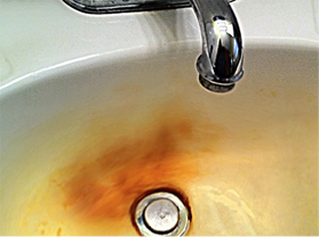Iron
|
Iron can be a troublesome chemical in water supplies. Making up at least 5 percent of the earth's crust, iron is one of the earth's most plentiful resources. As rainwater infiltrates the soil and underlying geologic formations, it dissolve iron, causing it to seep into aquifers that serve as the source for groundwater wells. Although often present in drinking water, iron is seldom found at concentrations greater than 10 milligrams per liter (mg/L) or parts per million (ppm). Concentrations of iron as low as 0.3 mg/L will leave reddish brown stains on fixtures, tableware, and laundry that is very difficult to remove.
Iron is mainly present in water in two forms: the soluble ferrous iron or the insoluble ferric iron. Water containing ferrous iron is clear and colorless because the iron is completely dissolved. When exposed to air in the pressure tank or atmosphere, the water turns cloudy and a reddish brown substance begins to form. |
HardnessHard water requires more soap and synthetic detergents for home laundry and washing, and contributes to scaling in appliances, boilers, and industrial equipment. Hardness is caused by compounds of calcium and magnesium, and by a variety of other metals. Water is an excellent solvent and can readily dissolve these minerals. As water moves through soil and rock, it dissolved very small amounts of minerals and holds them in solution. Calcium and magnesium dissolved in water are the two most common minerals that make water "hard".
The hardness of water is referred to by three types of measurements: grains per gallon, milligrams per liter (mg/L), or parts per million (ppm). The table to the right shows the hardness scale and corresponding values in grains per gallon and mg/L. |
|



